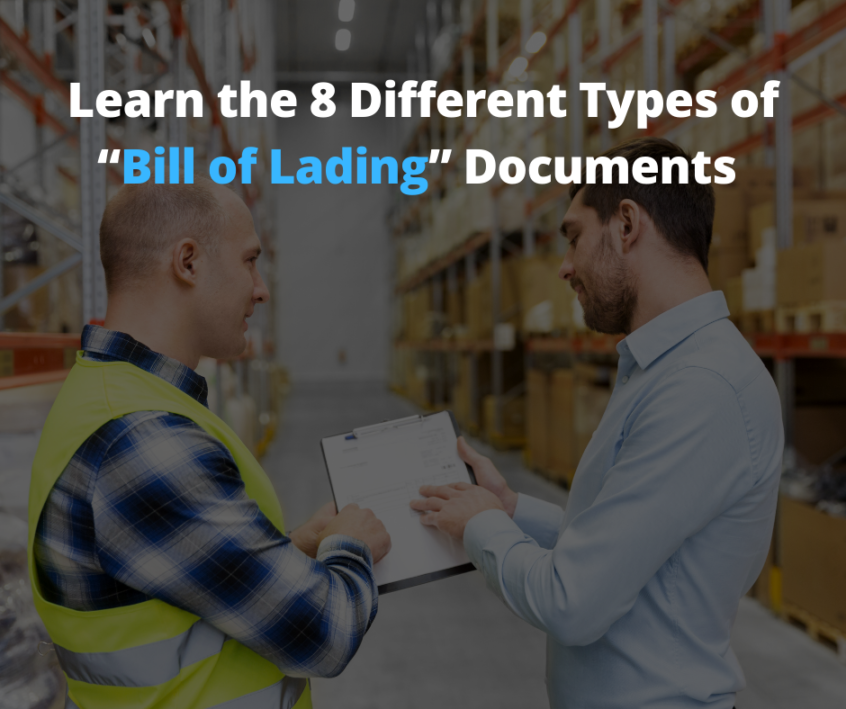
When You Should Use Them
The bill of lading (BoL) is an important document in the shipping industry to better understand its meaning and implications for operations. There are different categories of bill of lading, with each being used in specific situations for specific functions. It is hard to be functional or successful in shipping if you do not understand how a bill of lading operates.
The bill of lading is a legal document that a carrier issues to a shipper. It contains details of the cargo that is being transported. Key details may include the quantities and types of goods shipped. It also includes the delivery addresses. The common types include straight bill of lading, ocean bill of lading, order bill of lading, multimodal bill of lading, through bill of lading, master bill of lading, clean bill of lading, and release bill of lading.
Functions of a bill of lading
The functions of a bill of lading include:
- Evidence: A bill of lading is evidence of a contract of carriage. The details provided are the binding contract’s obligations and limitations, including destinations, typologies, quantities, and conditions.
- Receipt: This is a receipt for the transactions or the cargo that has been loaded. It is proof of ownership or responsibility.
- Title: The bill of lading is a title of goods. The implied contract is that the carrier will turn over the goods to the consignee or receiving party. That party must be noted on the BoL.
Different types of bills of lading and their functions
All the actors in the shipping industry will encounter one or more of these typologies of a bill of lading. It is essential to select the correct BoL for the proper purpose at the right time. We briefly summarize them below.
- Straight Bill of Lading
This is also known as a consignment bill of lading. In this case, the BoL is not negotiable. This type of BoL would be used if goods are already paid for or do not require payment on delivery. All that is required from the consignee is identification before the cargo is handed to them. The transportation and delivery are pre-negotiated without any room for amendments. It then becomes a receipt upon delivery. There are other sub-categories under this category.
- Short Form Bill of Lading
This is a straight bill of lading without the terms and conditions printed on the back. Others refer to it as the blank back bill of lading. These types of BoLs are rarely used because customers prefer the safety of having everything put down on paper. However, the courts will insert the back clauses as a matter of practice based on the idea that this is a short form of the full straight bill of lading.
- Blank endorsed bill of lading
This is a straight BoL yet to be endorsed, and the consignee has not yet been named. The holder of the bill can claim possession; hence, it is negotiable.
- On board bill of lading
This is sometimes referred to as the shipped-on board BoL. It is a notation placed on the BoL to indicate that the items are in suitable condition and have been transported on the specified vessel. Banks that fund shipments may require an on board BoL.
- On deck bill of lading
Used as proof of shipment, some exporters or manufacturers require it to get payment.
- Ocean bill of lading
This is a BoL required when the cargo is going to cross international waters. It is a collective invoice and evidential document which can act as a receipt from the carrier to the shipper. In addition to the standard contents, this BoL may specify the packaging used and the value of the cargo. Once goods are collected, the shipper receives the contract, which both the carrier and shipper must sign. Then, the receiver will be given the document and sign it.
- Inland bill of lading
Additional documentation is required if the cargo will travel via land initially before crossing international waters. It is the document required for materials to reach the shore before being shipped to another country. Both the ocean and inland BoL must export cars in many instances.
- Negotiable bill of lading
This type of BoL is used when the shipper wants to ensure certain specified terms and conditions are met before the shipment is released to the receiver. Hence, it can be used when the payment from the receiver is backed by a letter of credit. Banks typically require that BoL be made out to their orders if using letters of credit used as an importer, exporter, or professional banker.
- Order bill of lading
This is a negotiable BoL that is made out to someone. It can be transferred by delivery and endorsement. Ownership of the cargo can be transferred under the BoL or airway bill terms. It is the direct opposite of the straight BoL. Order BoLs can stop cargo from being delivered to unwanted parties. They also allow the consignee to transfer the title of goods to a third party once there is an endorsement and delivery of the original BoL.
Banks that issue letters of credit need to ensure that the shipment is secured. Hence, some of these documents are required to ensure that the consignment is not delivered to the applicant without their knowledge or acquiescence. Thus, they may make their BoL negotiable. The procedure is to issue the BoL to order of the issuing banks and from the exporter as defined in the credit transactions. Negotiable BoLs serve two main functions. First, they prevent delivery to the applicant (business or importer) since the consignment can only be handed over to the lawful holder of the original negotiable BoL. Secondly, they allow the bank to endorse and deliver BoL after receipt of a letter of credit from the importer.
- Multimodal or through bill of lading
Although different, multimodal and through BoLs are remarkably similar. The through BoL only involves one mode of cargo movement despite the different legs, inland waterways, and the sea. However, there needs to be at least two modes of cargo movement to complete the shipment successfully. That is why a multimodal BoL may replace its through counterpart. A case in point is a multimodal BoL covering both land and sea. Multimodal BoLs are typically issued by the Multimodal Transport Operator (MTO) and printed on the standard document from the International Federation of Freight Forwarders Associations. In that case, the MTO is responsible for the cargo during transportation, including loss, damage, and shortages. In contrast, the through BoL is issued by the carrier. Nevertheless, the carrier is on contract for the responsibility that specifically relates to the carriage instead of other parts of the journey.
- Master bill of lading
This can be a House Bill of Lading (HBL) or a Master Bill of Lading (MBL). The shipping carrier issues the MBL to either the Freight Forwarder or NVOCC Operator. In contrast, the HBL is issued by the Freight Forwarder or NVOCC Operator to the customer. Under MBL conditions, the shipper is the NVOCC operator, freight forwarder, or agent; the consignee is the freight forwarder office, NVOCC operator, counterpart, or destination agent.
- Clean bill of lading
This is a contract between shipper, carrier, and receiver for cargo crossing water overseas. It includes declarations that there was no loss or damage to the cargo during shipment. After a thorough inspection, this BoL is given to ascertain whether there are deviations in the quantity and quality of the cargo from when it was loaded. Other BoLs might be placed under this category even if they differ from a clean BoL. Examples include:
- Dirty bill of lading
This is a claused or foul BoL, which indicates some loss or damage during shipment. It acts as a receipt on arrival to confirm these deviations in case of future compensation claims. It is common practice for institutions and banks or finance companies to reject claused BoLs. Hence, the seller may struggle to get paid for them.
- Release bill of lading
This is also known as an express BoL. Under its terms, the carrier is obligated to provide cargo to the consignee who has been named without any original bills of lading (OBL) issued. It is a non-negotiable form of BoL but not a tile of the goods. They are used when the importer has credit with the supplier and has paid for the products before shipping.
- Switch bill of lading
This is a duplicate BoL for cargo when the primary BoL has already been issued. The cogisnee typically requests it from the owner of the vessel and would occur because the consignee does not wish to reveal the new buyer or the shipper’s identity.
Wrapping Up
A Bill of Lading is an important document that helps members of the supply chain move cargo effectively. There are several different types of bills of lading documents and each is used for a specific purpose. It’s important to understand how and when to use each so you can maximize the efficiency of your logistics program.


